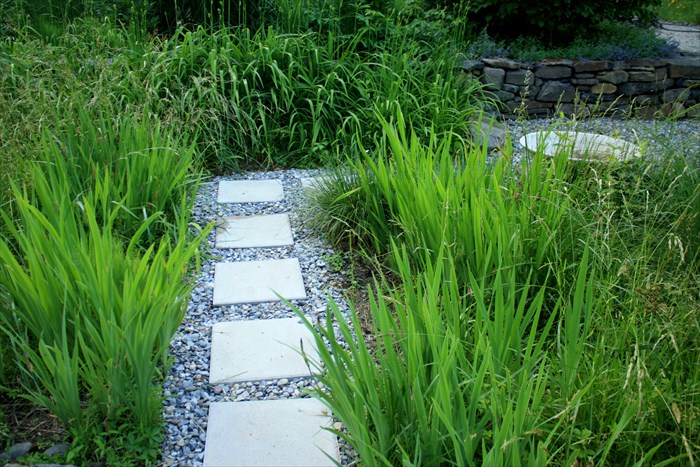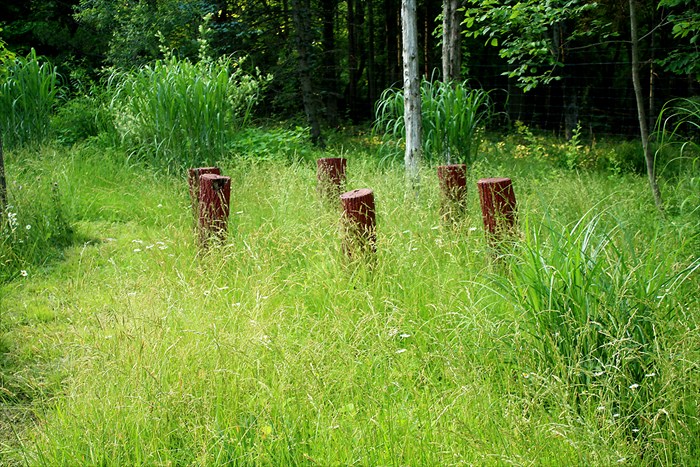Garden Diary: Integrating a new place

Perhaps a pool net isn't the ideal focal point for the newest part of the garden, but it does catch the eye and gives a sense of scale. And there's something about that blue I like.Not long ago this was a muddy mess. So goes garden construction in late winter. But now that's finished and spring planting is helping integrate this new part of the garden. Progress has been slow, with work limited mostly to one day each week. So goes the life of the long distance gardener, dividing time between city and country--on the country days, quickly using up the few available hours making rounds of nurseries, looking for appropriate plants even before the nurseries had plants on offer. I drove to Kurt Bluemel near Baltimore, to Fairweather Gardens in distant southern New Jersey, actually south of Wilmington, then around and around to the local places, asking, looking, hoping.And settling for what I could get.Not actually--I did get many special plants--20 Baptisia lactea, 25 Carex muskingumensis 'Oehme', 20 Aster tartaricus, two Baccharis halimifolia, assorted Sanguisorbas--but these are small and will make no impact until next year at best. The major screening plant is Miscanthus gracillimus, which serves both as a matrix for other plants and as a high, spreading ground cover. I used this largely because it's pretty in all seasons and it thrives in my difficult conditions, thus is reliable and resilient. And, of course, it's readily available.
Progress has been slow, with work limited mostly to one day each week. So goes the life of the long distance gardener, dividing time between city and country--on the country days, quickly using up the few available hours making rounds of nurseries, looking for appropriate plants even before the nurseries had plants on offer. I drove to Kurt Bluemel near Baltimore, to Fairweather Gardens in distant southern New Jersey, actually south of Wilmington, then around and around to the local places, asking, looking, hoping.And settling for what I could get.Not actually--I did get many special plants--20 Baptisia lactea, 25 Carex muskingumensis 'Oehme', 20 Aster tartaricus, two Baccharis halimifolia, assorted Sanguisorbas--but these are small and will make no impact until next year at best. The major screening plant is Miscanthus gracillimus, which serves both as a matrix for other plants and as a high, spreading ground cover. I used this largely because it's pretty in all seasons and it thrives in my difficult conditions, thus is reliable and resilient. And, of course, it's readily available.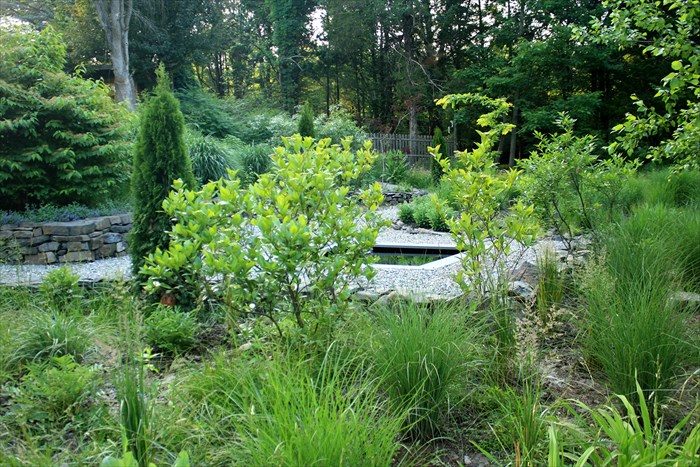 I want this to be a separate space, a refuge, both linked to and isolated from the rest of the garden. Screening the view in was important, to obscure the newness of the area, to blur the edges, to break up the hard lines, and to create privacy. Here Viburnum nudum 'Winterthur' remains where it has been planted for several years, but now it's surrounded by what I might describe to a stranger as a Piet Oudolf-style planting--though it's not at all like Piet Oudolf except in the most general way--in its emphasis on plant structure and form more than flower, use of lots of grasses, a love of seasonal change.The area between the pool and the main garden path contains closely planted Miscanthus gracillimus, Calamagrostis 'Karl Foerester', Pycnantheum muticum, and several large Sanguisorba tenuifolia. This is a wet, badly compacted area so, though I'd like to add other plants--other more delicate Sanguisorbas for example, and some very tall plants to emphasize separation of spaces--I'll wait a while to see how things grow here. For the interim, until plants completely cover the ground, I'll use bark mulch on the exposed surface. Only a temporary measure; I hate mulch as ground cover.
I want this to be a separate space, a refuge, both linked to and isolated from the rest of the garden. Screening the view in was important, to obscure the newness of the area, to blur the edges, to break up the hard lines, and to create privacy. Here Viburnum nudum 'Winterthur' remains where it has been planted for several years, but now it's surrounded by what I might describe to a stranger as a Piet Oudolf-style planting--though it's not at all like Piet Oudolf except in the most general way--in its emphasis on plant structure and form more than flower, use of lots of grasses, a love of seasonal change.The area between the pool and the main garden path contains closely planted Miscanthus gracillimus, Calamagrostis 'Karl Foerester', Pycnantheum muticum, and several large Sanguisorba tenuifolia. This is a wet, badly compacted area so, though I'd like to add other plants--other more delicate Sanguisorbas for example, and some very tall plants to emphasize separation of spaces--I'll wait a while to see how things grow here. For the interim, until plants completely cover the ground, I'll use bark mulch on the exposed surface. Only a temporary measure; I hate mulch as ground cover.
To reinforce that feeling of refuge, I restricted access, so entry is by this narrow path that literally takes you out of the garden mainstream.
You can glimpse this area from other parts of the garden, but you have to find the way in. Once there, access up to the house terrace via stairs is clear and, if you're so inclined, there's a mown pathway behind the plantings where you can meander through the wildness, wander back to the main garden path at a more distant point.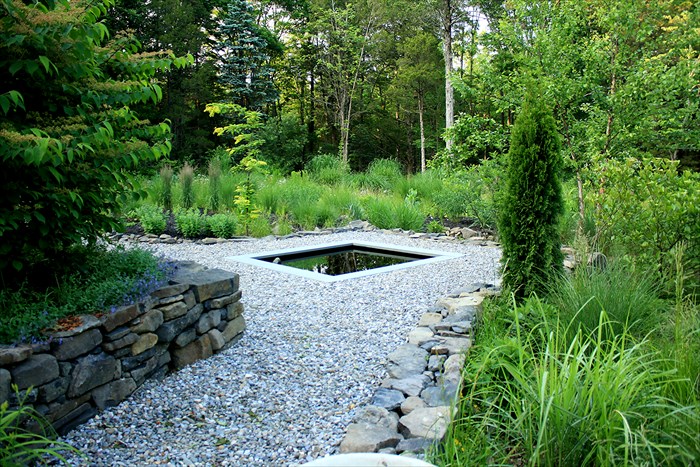 The mown, unpaved secondary path is for explorers, and runs behind the new plantings above, from left to right, opening out here at the main path, a distance of, I'd guess, about 150 feet:
The mown, unpaved secondary path is for explorers, and runs behind the new plantings above, from left to right, opening out here at the main path, a distance of, I'd guess, about 150 feet:
No plants in or around the pool though. I've thought of a couple of planters with flowering annuals, but that seems inappropriate to the wildness of this place, too domesticated, too suburban. I think I need to wait to see how this feels once the background vegetation has matured.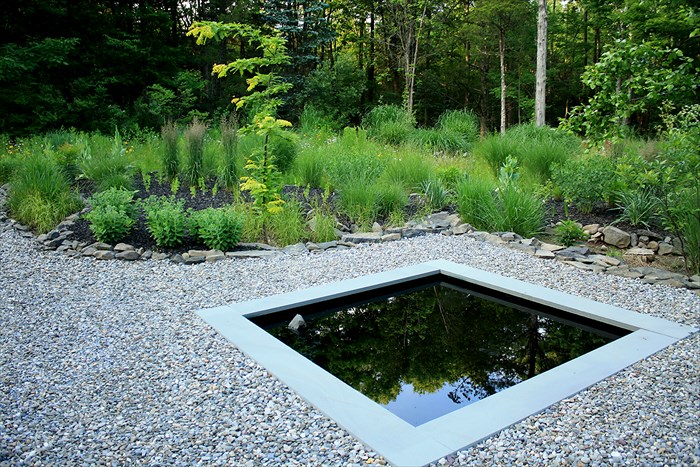 In the meantime, I may stick with minimal seating and a spot of color. Perhaps two or three low logs used as stools, painted a light blue, something like the blue of the net handle in the first photo. Or the blue of the sky reflected in the water.
In the meantime, I may stick with minimal seating and a spot of color. Perhaps two or three low logs used as stools, painted a light blue, something like the blue of the net handle in the first photo. Or the blue of the sky reflected in the water.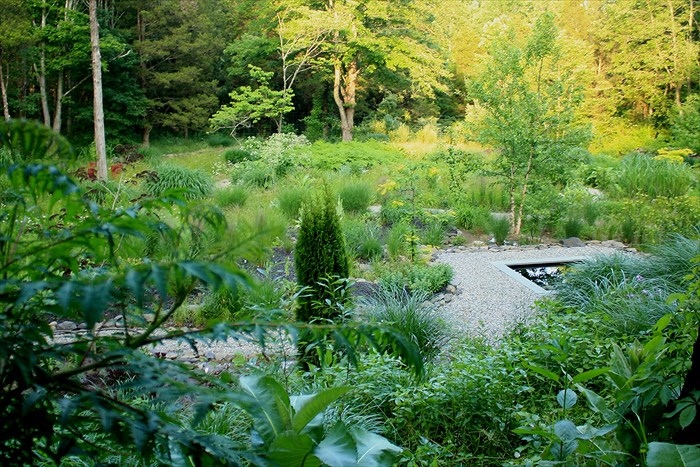 Or even the hints of blue sky reflected off the surfaces of the Rhus typhina leaves in the foreground above.
Or even the hints of blue sky reflected off the surfaces of the Rhus typhina leaves in the foreground above.

